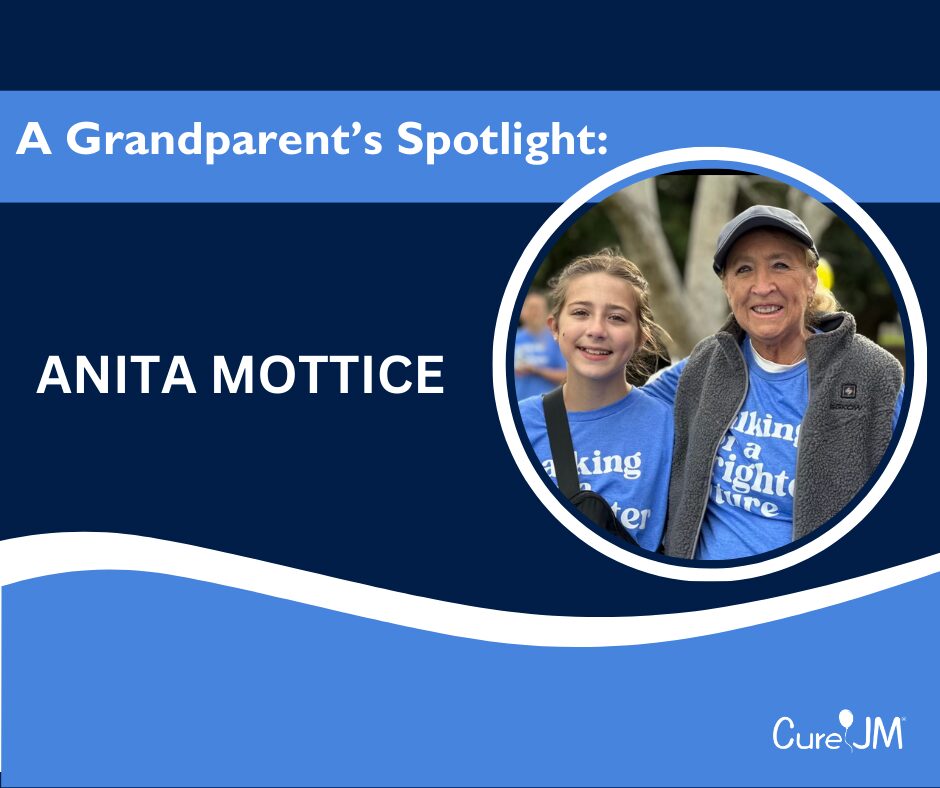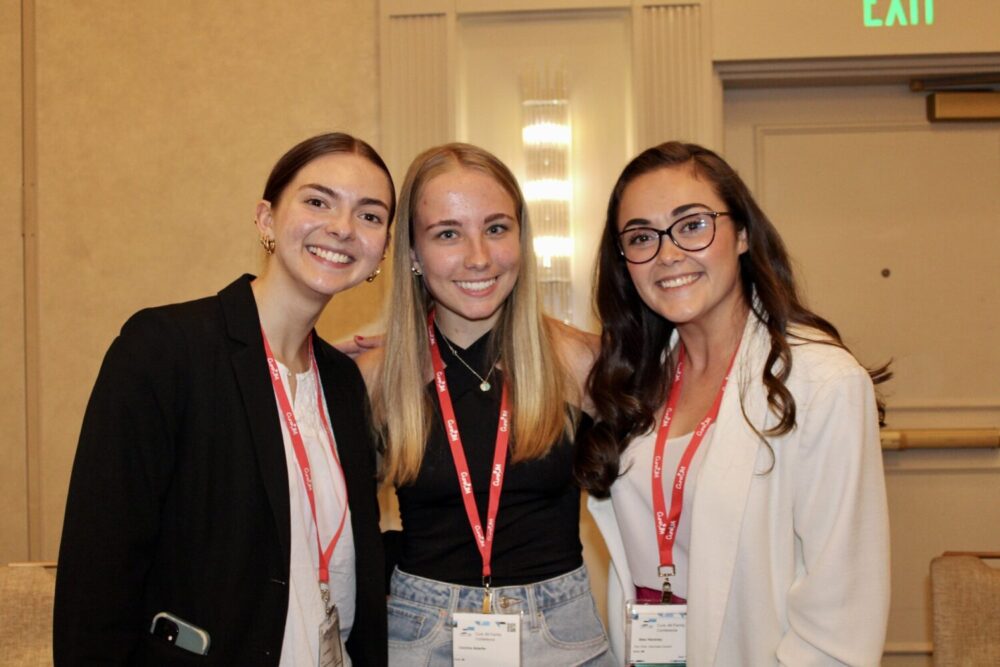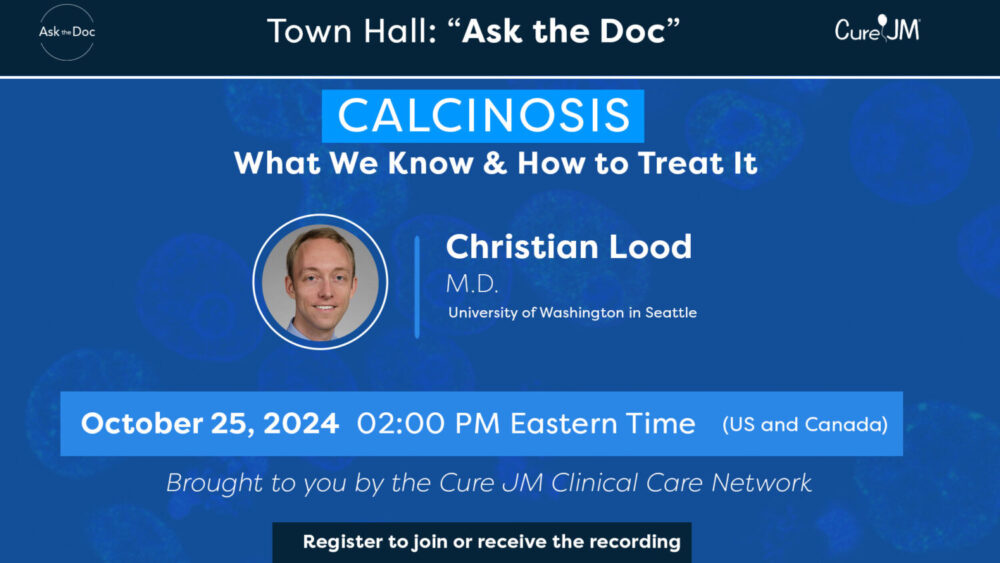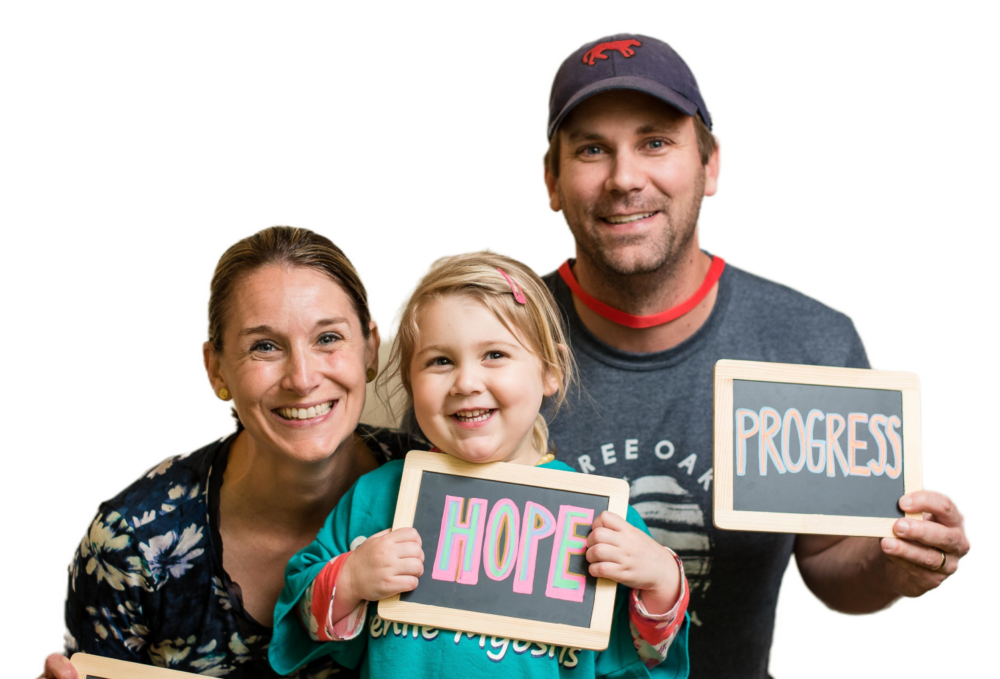GCOM — Day 1 Opening with Influence & Innovation
Today was a most impressive day for Cure JM at the Global Conference for Myositis. The conference brings together leading myositis researchers from around the world to share results and collaborate on future projects leading to better care and improved treatments for our JM kids.
Dr. Jessica Turnier presented opening remarks on how her research aims to fill a major gap in understanding what occurs “inside the cell” in patients. Outcomes of the research will lead to major targeted treatments, new biomarkers predicting flare, and better treatment responses and prognosis.
Dr. Turnier (University of Michigan) is one of several Cure JM-funded principal investigators collaborating on this research. Others include Dr. Jessica Neely from the Cure JM Center of Excellence at UC San Francisco, Dr. Jeff Dvergsten of the Cure JM Center of Excellence at Duke University, and Dr. Andrew Heaton, Cure JM’s Chief Scientific Officer.
It is also noteworthy that this opening session on the pathogenesis (or “causes”) of inflammatory myopathies was moderated by Dr. Neely and Dr. Andy Mammen of Johns Hopkins and member of the Cure JM Medical Advisory Board. Dr. Mammen is overseeing an upcoming clinical trial in myositis for the Bristol Meyers Squibb drug, deucravacitinib.
The influence and research leadership our “small but mighty” organization brings to pediatric rheumatology never ceases to amaze me. You, our parents, grandparents, and contributors have created the environment where JM research has flourished in recent years, frankly, because of your forward-looking and generous philanthropy.
At a global conference like this, it is incredibly rewarding to see the recognition afforded our truly brilliant research teams you have funded.
Coming up on today’s and tomorrow’s agenda are presentations from Cure JM Medical Advisory Board members Dr. Lisa Rider (NIH), Dr. Lucy Wedderburn (University College London), and Dr. Christian Lood (Cure JM Center of Excellence, Seattle Children’s) on promising avenues for new therapies in JM. There is also an entire session with additional Cure JM researchers working on clinical trials, and I will report back to you on Day 2 with what I’m confident will be exciting news.
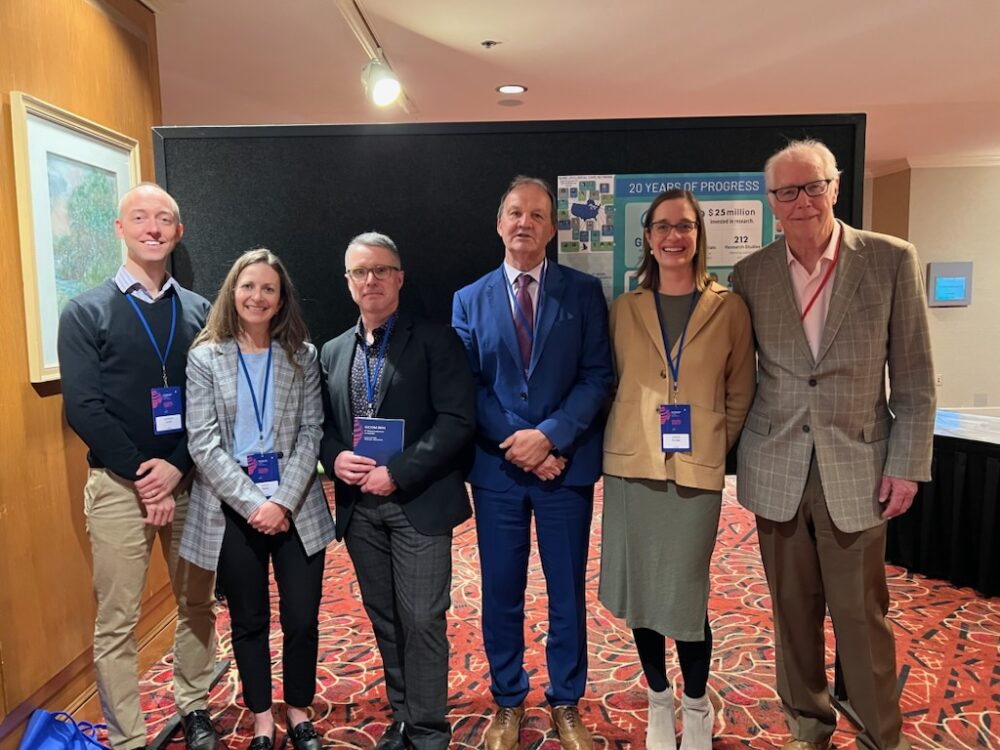
Pictured from Left to Right: Doctors Christian Lood, Jessica Neely, Adam Huber, Andrew Heaton, Jessica Turnier and Jim Minow, Cure JM Executive Director
GCOM Day 2 –The Very Real Promise of CAR-T Therapy in Myositis
I expected to hear promising news about the potential for CAR-T therapy to treat myositis on Day 2 of GCOM. GCOM is the Global Conference on Myositis.
What we heard was more than promising—it was astounding.
What if I told you that there was a therapy that would “reset” the immune system—virtually eliminating the autoimmune response in myositis that causes inflammation, pain, muscle weakness, and other JM conditions of which we are all too familiar.
That “reset” exists today and is approved for use of certain blood cancers. A next frontier is to target rheumatic autoimmune diseases such as myositis and lupus, and early clinical trial results are very, very encouraging.
The most notable results come out of Germany, where 15 patients including three myositis patients as young as 20, completed the trial. All of the patients saw remarkable and lasting improvement—some of up to three years of being “disease free.”
Results were reported by Dr. Georg Schett, head of the Department of Rheumatology and Immunology at Friedrich-Alexander University in Erlanger-Nurnberg, who led the trial and was the keynote speaker at GCOM.
Schett presented a visionary scenario where in rheumatic diseases such as lupus and myositis, Car-T therapy will emerge as a “living drug” leading to the absence of disease eliminating the necessity for ongoing treatment. Current JM treatments, as we know all too well, suppress the immune system and usually lead to clinical improvement, but do not eliminate the disease.
We also heard from Dr. Carl June, a pioneer in Car-T therapies used in cancer, who noted that autoimmune diseases present the next frontier of research with an “explosion of research and investment” in just the last year. “We can learn much from CAR-T’s success in oncology,” June noted, likening the process to a bone marrow transplant. June is the Director of the Center of Cellular Immunotherapies at the University of Pennsylvania Perelman School of Medicine.
June also serves as a medical advisor to Cabaletta Bio, which has a CAR-T therapy platform specifically designed for autoimmune diseases such as lupus and myositis. Dr. David Chang, Cabaletta’s Chief Medical Officer, served as the moderator of the CAR-T “Achieving Remission” session. Cure JM families may remember Dr. Chang from the 2023 Family Conference where he shared Cabaletta’s progress with Cure JM’s Medical Advisory Board.
I will share with you more information on upcoming CAR-T clinical trials in myositis along with a guide on the process of “How CAR-T works.” Of the 15 patients in Dr. Schett’s trial side effects were minimal, short-term, and when they did occur, proved to be manageable.
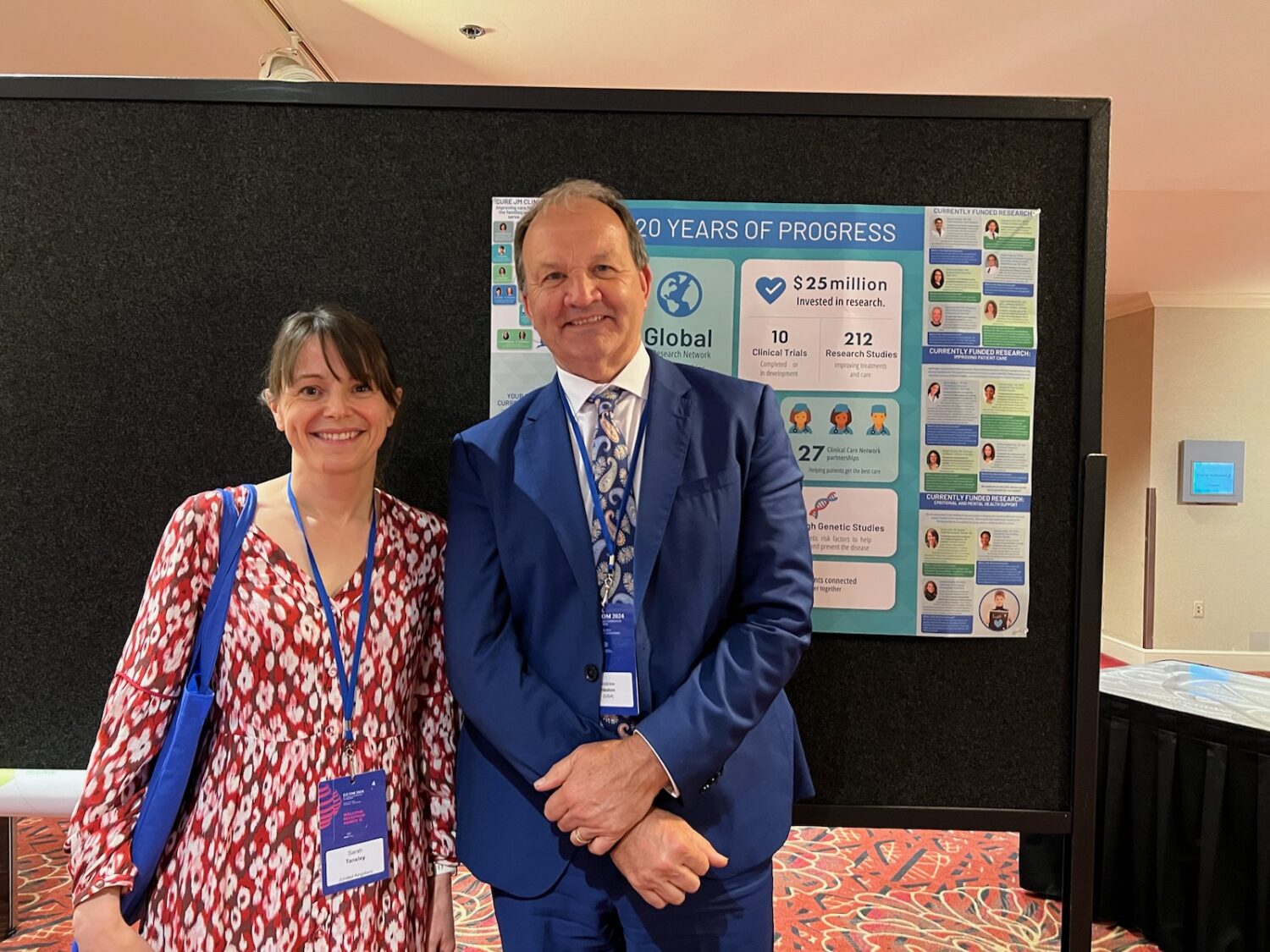
Dr. Sarah Tansley and Dr. Andrew Heaton, Cure JM Chief Scientific Officer
Day 3 at the Global Conference on Myositis: Clinical Trials Usher in Historic Progress
The inescapable takeaway from the Global Conference on Myositis is that we have entered an exciting era of clinical trials for new therapies for JM. Moreover, this work is accelerating as inflammatory autoimmune myopathies such as JM, lupus, and adult forms of myositis are diseases that are increasingly targeted by biotech startups an established pharmaceutical companies for new clinical trials.
In just this past year we’ve seen the successful completion of the clinical trial for the drug abatacept (Orencia) at the Cure JM Center of Excellence at George Washington University, the FDA approval of Octagam 10 (IVIG) for dermatomyositis, the FDA approval of vamorolone (an alternative steroid with fewer side effects), and the FDA approval of a clinical trial design for the use of baricitinib in JM. The new steroid vamorolone is not yet approved for use in JM, but we are optimistic that our clinical trial design developed in collaboration with the Cure JM Center of Excellence at Duke University will soon be approved by the FDA.
As one parent recently told me, “The introduction of abatacept to my daughter’s care resulted in significant improvement and literally changed her life.”
Other clinical trials in JM (such as for the Bristol Meyers Squibb drug deucravacitinib) are in development and financially supported by Cure JM.
And so, all of this progress leads to another important observation: these trials won’t move forward without you—our families and patients. More than ever, we will need JM patients to participate in these trials and to be a part of advancing historic therapies.
I also want to thank those JM patients who have so generously given their time and effort to participate in recent clinical trials, such as for abatacept or the sodium thiosulfate trial in calcinosis at NIH, the results of which are about to be published. And let’s never forget those of you who participated in the rituximab trial over a decade ago—a first for JM. The outcome of this trial led to rituximab being introduced as a primary treatment option for children who struggle with first-line steroids and methotrexate.
Rituximab works by destroying certain B-cells that circulate through the blood and that are a part of the body’s immune system. When these B cells misbehave, it causes an autoimmune condition such as JM.
Rituximab destroys many, but not all, of the atypical B -cells, leading to clinical improvement in many JM patients. However, because not all of the B-cells are destroyed, they can repopulate, leading to the need for ongoing rituximab infusions.
In simplest terms, the promise of CAR-T therapy is that it replaces the patient’s atypical B-cells with modified cells, effectively stopping the autoimmune process of the body attacking muscles, skin, blood vessels, and internal organs. We have much yet to learn as we move into CAR-T clinical trials in JM, but early evidence suggests that it has enormous potential as a therapy for chronic JM patients resistant to current first-line treatments.
